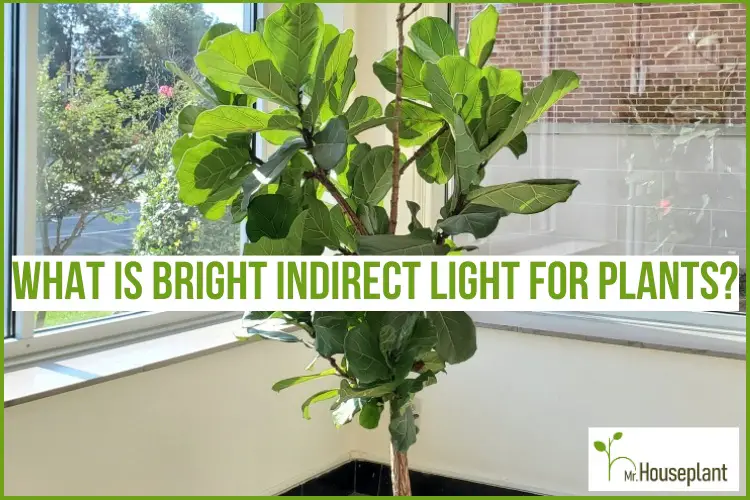
There aren’t many things that confuse plant parents as much as the notion of bright indirect light. One of the reasons is that although it might be easy to define bright indirect light in general terms, when it comes to its practical use, many variables need to be taken into account.
The questions I usually get from indoor gardening lovers range from what exactly bright indirect light is to how it differs from direct light. Read on to find out what are the proper lighting conditions for your indoor garden. Learn everything about bright indirect light and its importance for your plants and indoor garden.
Direct light is when the sun is shining directly onto the leaves of a plant. If you’re in the position of a plant, the plant can see the sun from it’s location.

Example of direct light: the sun is shining on the fiddle leaf fig plant
What Is Indirect Light?
Indirect light is any light that is not direct, that is, whenever the sun isn’t shining directly onto the leaves of a plant, this is indirect light.
What Is the Difference Between Direct Sun (Direct Sunlight) and Direct Light?
There is no difference between direct sun and direct light. Direct sun, direct sunlight. direct light and bright direct light are all synonyms. These synonyms are used when the sun is shining directly onto the leaves of a plant.
What Is Indirect Sunlight?
Indirect sunlight has the same meaning as indirect light, however indirect sunlight is a bit of a misleading term. The word “sunlight” can be the cause of confusion as the word “sunlight” alone refers to direct sun. It’s more clear to use the term indirect light instead of the term indirect sunlight.
What Is Bright Indirect Light?
Bright indirect light is indirect light over 3,000 lux (300 foot candles).
What Does Bright Indirect Light Mean?
Bright indirect light means indirect light (light where the sun isn’t shining directly on the plant’s leaves) of intensity over 3,000 lux (300 fc). Most house plants need bright indirect light to grow well and be happy and healthy. But if you give them stronger bright indirect light (over 10,000 lux or 15,000 lux = over 1,000 or 1,5000 foot candles), this will increase photosynthesis, speed up their growth and most plants will be happier and healthier.
How to Measure Bright Indirect Light?
There are two ways to measure bright indirect light. Bright indirect light can be measured with:
- a light meter or
- a light meter app.
How to Measure Light with a Light Meter
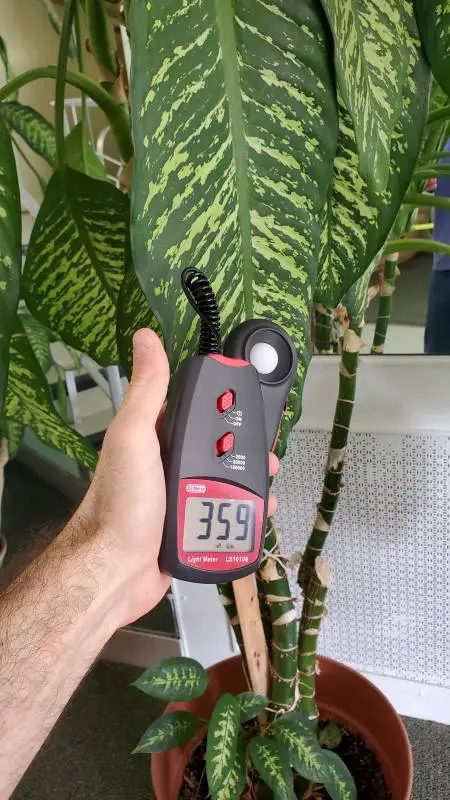
Measuring light with a light meter on my beautiful houseplant
The best way to measure natural light is with a light meter. Light meters are inexpensive tools that cost between $20-30. They are very user-friendly. You just need to position them above a plant and point them towards the window/light source. The meter will show the amount of light your plant is getting at that particular moment.
For most plants the goal is to have bright indirect light (light over 3,000 lux), but the more indirect light you can provide the better. If you can provide 10,000-15,000 lux your plant will grow even faster and be much happier. The amount of light in your home will depend on the time of day. A light meter will show different light levels at different times of day.
How to Measure Light with a Light Meter App
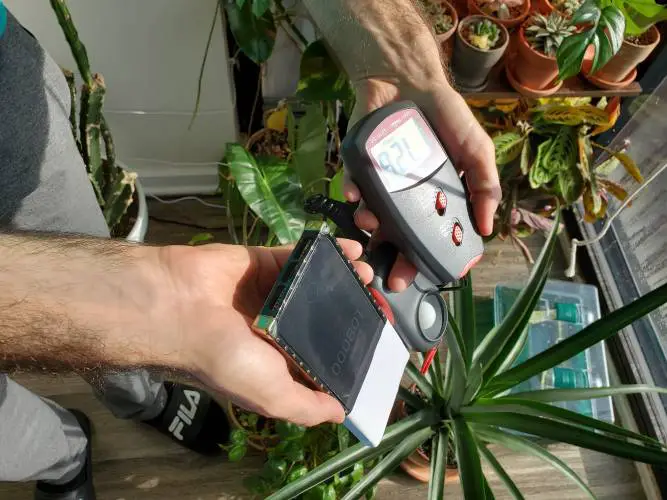
Comparing light measurements from Photone and light meter
I would always choose light meters over apps. Why? The reason is simple. These apps are imprecise because they aren’t calibrated for different mobile phone types. And to calibrate them, you need to use a light meter. This makes the apps entirely redundant (and futile).
However, there is always an exception to the rule. There is an app that I do recommend, and it is called Photone. What sets it apart from other apps is that it is already calibrated for different mobile phone types. In my experience, it shows the correct measures 9 out of 10 times.
Can I See a Bright Indirect Light Example?
Here is a bright indirect light example in a home:
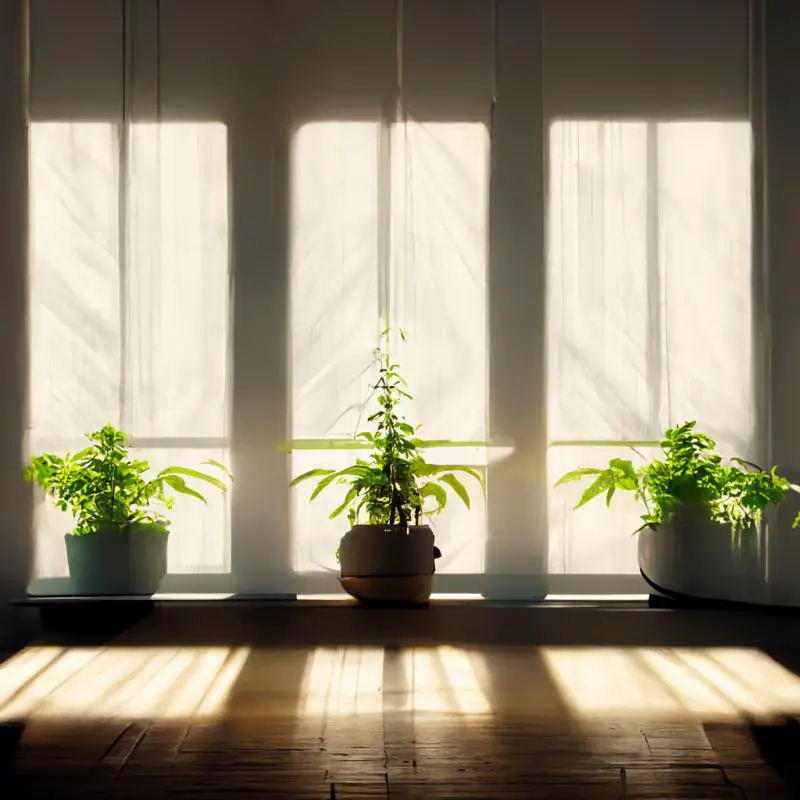
Bright Indirect Light: the plants are in front of a bright window with unobstructed view of the sky, but the sun is not shining directly on the leaves of houseplants
What is also important to mention is that, without a light meter you can only estimate the amount of indirect light your plant is getting. Our pupils dilate in low light, so a place that seems super bright for us might not be that bright for our plant. The only way to know for sure is to use a light meter. But what if you don’t have one yet?
If I Don’t Have a Light Meter, How Can I Make Sure My Plant is Getting Bright Indirect Light?
If you don’t have a light meter, the best way to make sure your plant gets bright indirect light is by placing the plant in front of the brightest window with an unobstructed view of the sky. I really mean in front of it. Not a few feet away, not to the side of it, not tucked away in the corner of your room. In addition, blinds should be fully lifted, and curtains open. Ideally, plants should be in a spot with an unobstructed view of the sky. What do I mean by that? There shouldn’t be any large trees, awnings, or buildings blocking the view of the sky. If you want your plants to thrive, bright indirect light is the key. And you should have it by following all the previously mentioned advice. But once again, without a light meter, you can’t tell for certain how much light your plant gets.
Medium indirect light means indirect light (light where the sun isn’t shining directly on the plant’s leaves) between 750 lux (75 foot candles) and 3,000 lux (300 foot candles).
What Does Full-Sun Mean?
Full-sun means that your plant is exposed to direct sun for most of the day. It will depend a lot on your plant type, but this type of overexposure can damage or even kill your plant. As a general rule of thumb, keeping your plant in direct sun in the early morning or late afternoon is okay, for 1-2 hours.
What Is Filtered Light?
Filtered light is pretty much a synonym for indirect light. Filtered light means that your plant is getting direct sun, but it is shielded from sun rays by a sheer curtain. The curtain acts like a buffer that softens the sun’s ray and prevents your plant from being sunburnt.
Is Light Through a Window Considered Direct Sunlight?
Yes, light through a window is considered direct sunlight. If the sun directly falls on your plant’s leaves (even through a window), that is direct sunlight. The intensity of direct sun through a window is lower compared to direct sun outdoors. But it is still considered direct sunlight. Note that too much exposure even through a window can cause sunburns.
If there is a white curtain on the window in front of your plant, it is no longer direct sunlight but indirect, filtered light.
How to Tell If Your Indoor Plant Is Getting Enough Light?
There are two ways to tell if your indoor plant is getting enough light:
- By measuring the intensity of light with a light meter and comparing it to the values in the table I am sharing with you at the end of this article and
- by observing the growth of the plant
When it comes to measuring light for plants, the values I provided in the table are based on different resources such are agricultural extensions and books, adjusted based on my personal observations in the last 10 years of working with houseplants.
These aren’t strict requirements but rather recommendations. The values represent the minimal amount of light that low-light tolerant, medium-light tolerant, or bright light plants will be able to survive and thrive.
If we speak about observing the plant’s growth, a few indicators can tell if your plant is getting enough light. If your plant puts out new growth, leaves have their expected size, and are healthy, it usually means your plant is getting enough light. If internodes (spaces between leaved/nodes) are of the same size and are not increasing, this is usually a sign your plant is getting sufficient light. However, if the stems are long and spindly and internodes are get bigger, that isn’t a good sign. It implies that your plant isn’t getting enough light.
Sometimes, small leaves can indicate insufficient light, but I would like to point out that you shouldn’t base your opinion on this factor. There could be multiple reasons for leaves being small. So don’t immediately jump to the conclusion that it is the lack of light.
How Does Houseplant Placement/Location Affect the Level of Light It Gets?
The placement/location of your houseplant considerably affects the level of light it will get. Light intensity drops significantly with distance. The further your plant is from the window, the less light it gets. In other words, light intensity decreases exponentially with distance. Putting your plant 3 feet away from a window, instead of near a window, will greatly reduce the amount of light your plant gets. What also plays a role is the unobstructed view of the sky. The larger the unobstructed view of the sky a plant has, the more light it’s getting.
And it isn’t only the placement of the plant that affects the light intensity. It is also the window position.
South Facing Window
A south facing window will provide the most light for indoor plants if you live in the northern hemisphere. It will also provide the biggest amount of direct sunlight, especially in winter months when the sun is lower in the sky.
West Facing Window
The second best would be west facing windows, they get somewhat less indirect light, and less hours of direct sunlight, later in the afternoon.
East Facing Window
They are followed by the east facing windows. East facing windows get a somewhat lower amount of indirect light for plants, and a shorter amount of direct sunlight as well, early in the morning.
North Facing Window
The worst option for indoor plants are the north facing windows, as they get the least amount of indirect light, and no direct sun.
If you live in the Southern hemisphere, the situation is reversed. The north facing windows get the most light, followed by west facing windows, then east facing windows, whereas the south facing windows get the least amount of light.
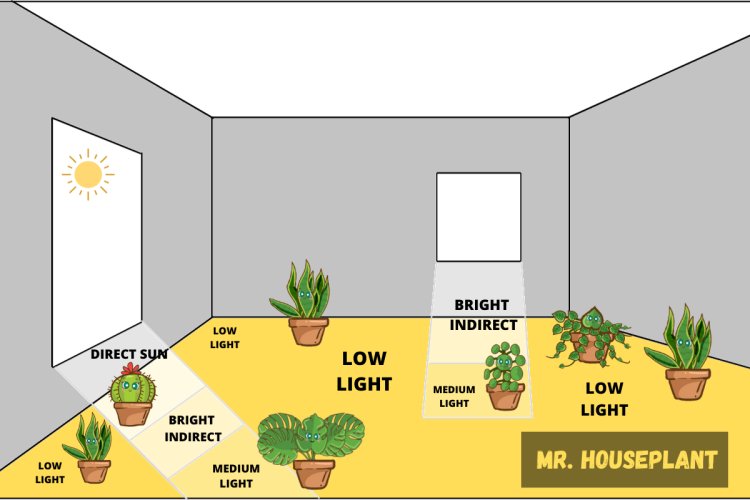
A diagram of bright indirect light, medium light, low light and direct sunlight
How to Provide Bright Indirect Light for Your Plants?
To provide bright indirect light for your plants, place your plant on the window ledge or in front of the brightest window. If you can’t put it right in front of the window, put it as near as possible. The closer to the window, the better (each foot away from a window makes a big difference). If you do have more than one window to choose from, choose the southern one (in the northern hemisphere), or the northern one (in the southern hemisphere). The window where you put your plant should have a clear, unobstructed view of the sky, with no trees, buildings or awnings blocking the view.
What Can You Do If You Can’t Provide Bright Indirect Light for Your Plants?
If you can’t provide your plants bright indirect light, consider getting grow lights or getting plants that are low light tolerant. Of course, in an optimal situation, you’ll be living in a flat with large windows, a clear view of the sky, and windows facing just the right direction. Unfortunately, this is often not possible. But fortunately, the rescue comes in the form of artificial lights (grow lights). If you choose a good, tested artificial light, you can achieve the equivalent of bright indirect light. Even direct sunlight.
There are some important things you need to take into account when using a grow light:
- Choosing a good grow light, the one which produces sufficient intensity. Usually, people tend to buy very weak ones that only work at very close distances, 2-4 inches away.
- Setting it up properly: remember that the light intensity drops with distance. Keep this in mind when positioning your grow light.
- Adjusting the duration, that is, how long the light will be on. I keep my lights on from 8-16 hours per day. The duration depends on whether you are just supplementing natural light or replacing it.
If you want to know more about this topic, check out my post on the best and affordable LED grow lights for your houseplants.
How Much Light Does My Plant Need?
To determine how much light your plant needs, check out the values in the table below.
The amount of light listed in the minimal amount column is the bare minimum that the plant needs in order to look ok.
The optimal amount is the minimum you should be aiming for. But the more light you can provide the better. Low light tolerant and medium indirect light plants will love receiving bright indirect light!
Commercial light levels are the levels used by nurseries in commercial production of houseplants. I added them as a demonstration of just how high light levels are being used in commercial production. Since we can’t provide even close to those amounts of light at home, we shouldn’t expect our plants to look as great or grow as fast as plants in nurseries.
Can A Plant Have Too Much Indirect Light?
No, a plant cannot have too much indirect light. The more indirect ligh you can provide to a plant, the better off the plant will be. More light equals more photosynthesis equals faster, bigger growth and a healthier plant.
Can A Plant Have Too Much Direct Light?
Yes, a plant can have too much direct light. Too much direct light (direct sunlight) can cause bleaching of the leaves and sunburns and can stress a plant. This is why the table below lists direct sun tolerance for each plant.
Direct and Indirect Light Requirements By Plant
| CATEGORY | PLANT NAME | MINIMAL AMOUNT OF LIGHT | OPTIMAL AMOUNT OF LIGHT | DIRECT SUN TOLERANCE | COMMERCIAL LIGHT LEVELS |
|---|---|---|---|---|---|
| low light tolerant | Aglaonema (Chinese evergreen) | 50 Lux (5 FC) | 750+ lux (75+ FC) | 1-2 hours | 1000-2400 FC |
| low light tolerant | Aloe | 500 lux (50 FC) | 40,000+ lux (4,000+ FC) | 8 hours | |
| medium light | Air plants | 1,000 lux (100 FC) | 2,500+ lux (250+ FC) | 1-2 hours | 3000-7000 FC |
| medium light | African Violets | 1,000 lux (100 FC) | 2,500+ lux (250+ FC) | 2-3 hours | 1000-1200 FC |
| medium light | Alocasia | 1,000 lux (100 FC) | 2,500+ lux (250+ FC) | 3-4 hours | 2000-5000 FC |
| medium light | Anthurium (several species) | 1,000 lux (100 FC) | 2,500+ lux (250+ FC) | 1-2 hours | 1500-2000 FC |
| low light tolerant | Aspidistra (Cast-Iron Plant) | 50 Lux (5 FC) | 750+ lux (75+ FC) | 1-2 hours | 2000-5000 FC |
| medium light | Areca Palm | 1,000 lux (100 FC) | 2,500+ lux (250+ FC) | 1-2 hours | 5000-6000 FC |
| medium light | Arrowhead vine (Syngonium podophyllum) | 1,000 lux (100 FC) | 2,500+ lux (250+ FC) | 3-4 hours | 1500-3000 FC |
| medium light | Begonia | 1,000 lux (100 FC) | 2,500+ lux (250+ FC) | 1-2 hours | 2000-2500 FC |
| full sun | Bird of paradise (Strelitzia) | 10,000 lux (1,000 FC) | 40,000+ lux (4,000+ FC) | 8 hours | |
| medium light | Calathea | 1,000 lux (100 FC) | 2,500+ lux (250+ FC) | 1-2 hours | 1000-2000 FC |
| full sun | Cactus | 10,000 lux (1,000 FC) | 40,000+ lux (4,000+ FC) | 8 hours | 5000 FC |
| medium light | Ceropegia Woodii | 1,000 lux (100 FC) | 2,500+ lux (250+ FC) | 3-4 hours | |
| medium light | Cordyline | 1,000 lux (100 FC) | 2,500+ lux (250+ FC) | 3-4 hours | 3000 FC |
| bright light | Croton | 3,000 Lux (300 FC) | 5,000+ lux (500+ FC) | 3-4 hours | 3000-5000 FC |
| medium light | Dumb cane (Dieffenbachia) | 1,000 lux (100 FC) | 2,500+ lux (250+ FC) | 3-4 hours | 1500-3000 FC |
| low light tolerant | Dracaena (corn plant, dragon tree, dragon plant) | 50 Lux (5 FC) | 750+ lux (75+ FC) | 1-2 hours | 2000-3000 FC |
| medium light | English Ivy (Hedera Helix) | 1,000 lux (100 FC) | 2,500+ lux (250+ FC) | 2-3 hours | 1500-2500 FC |
| medium light | Hoya (several species) | 1,000 lux (100 FC) | 2,500+ lux (250+ FC) | 3-4 hours | 1500-2000 FC |
| medium light | Ferns (Boston fern, maidenhair fern, Bird’s nest fern) | 1,000 lux (100 FC) | 2,500+ lux (250+ FC) | 1-2 hours | 1500–3000 FC |
| full sun | Ficus (Ficus Elastica, rubber tree; Ficus Lyrata, fiddle leaf fig; Ficus Benjamina) | 5,000 lux (500 FC) | 40,000+ lux (4,000+ FC) | 8 hours | 2000-6000 FC |
| medium light | Fittonia (Nerve plant) | 1,000 lux (100 FC) | 2,500+ lux (250+ FC) | 1-2 hours | 1500-2500 FC |
| full sun | Jade Plant (Crassula ovata, other Crassulas) | 3,000 Lux (300 FC) | 5,000+ lux (500+ FC) | 8 hours | 5000-6000 FC |
| medium light | Maranta (prayer plant) | 1,000 lux (100 FC) | 2,500+ lux (250+ FC) | 2-3 hours | 1000-2500 FC |
| low light tolerant | Marimo Moss Ball | 50 lux (5 FC) | 750+ lux (75+ FC) | 0 hours | |
| medium light | Monstera deliciosa (Swiss cheese plant) | 1,000 lux (100 FC) | 2,500+ lux (250+ FC) | 2-3 hours | 1000-2500 FC |
| bright light | Norfolk Island Pine | 3,000 Lux (300 FC) | 5,000+ lux (500+ FC) | 2-3 hours | 5000-6000 FC |
| medium light | Parlour palm (Chamaedorea Elegans) | 1,000 lux (100 FC) | 2,500+ lux (250+ FC) | 1-2 hours | 1500-3000 FC |
| low light tolerant | Peace Lily (Spatiphyllum) | 50 Lux (5 FC) | 750+ lux (75+ FC) | 1-2 hours | 1500-2500 FC |
| medium light | Peperomia (multiple species incl. String of turtles (Peperomia Prostrata), Watermelon Peperomia (Peperomia Argyreia)) | 1,000 lux (100 FC) | 2,500+ lux (250+ FC) | 2-3 hours | 1500-3500 FC |
| medium light | Phalaenopsis (Moth orchid) | 1,000 lux (100 FC) | 2,500+ lux (250+ FC) | 2-3 hours | 1000-1500 FC |
| low light tolerant | Philodendron vines (Heartleaf philodendron, philodendron Brasil…) | 50 Lux (5 FC) | 750+ lux (75+ FC) | 1-2 hours | 1500-3000 FC |
| medium light | Philodendron (Pink Princess, Prince of Orange, Red Congo, Moonlight, Burle Marx…) | 1,000 lux (100 FC) | 2,500+ lux (250+ FC) | 2-3 hours | 1500-2500 FC |
| medium light | Pilea (Pilea peperomioides, Chinese money plant) | 1,000 lux (100 FC) | 2,500+ lux (250+ FC) | 3-4 hours | 1000-2000 FC |
| full sun | Pineapple (Ananas Comosus) | 10,000 lux (1,000 FC) | 40,000+ lux (4,000+ FC) | 8 hours | |
| medium light | Polka Dot Plant (Hypoestes) | 1,000 lux (100 FC) | 2,500+ lux (250+ FC) | 2-3 hours | 3000-3500 FC |
| low light tolerant | Pothos (Golden pothos, devil’s ivy, Epipremnum Aureum; Scindapsus Pictus) | 50 Lux (5 FC) | 2,000+ lux (200+ FC) | 3-4 hours | 3000-5000 FC |
| medium light | Rhaphidophora Tetrasperma | 750 lux (75 FC) | 3,000+ lux (300+ FC) | 2-3 hours | |
| medium light | Schefflera (Umbrella tree, Schefflera Arboricola, Schefflera Actinophylla, dwarf schefflera) | 1,000 lux (100 FC) | 2,500+ lux (250+ FC) | 2-3 hours | 5000-7000 FC |
| bright light | Schlumbergera/Rhipsalidopsis (Christmas cactus, Thanksgiving cactus, Easter cactus) | 3,000 Lux (300 FC) | 5,000+ lux (500+ FC) | 3-4 hours | 1500-3000 FC |
| medium light | Senecio Rowleyanus (String of Pearls), String of Dolphins (Senecio Peregrinus) | 1,000 lux (100 FC) | 2,500+ lux (250+ FC) | 1-2 hours | |
| low light tolerant | Snake plant (Sansevieria, Mother-in-law’s tongue) | 50 Lux (5 FC) | 750+ lux (75+ FC) | 5-6 hours | 1000-6000 FC |
| medium light | Spider Plant (Chlorophytum) | 1,000 lux (100 FC) | 2,500+ lux (250+ FC) | 3-4 hours | 1000-2500 FC |
| medium light | Staghorn Fern (Platycerium) | 1,000 lux (100 FC) | 2,500+ lux (250+ FC) | 3-4 hours | 1000-2000 FC |
| medium light | Stromanthe Sanguinea | 750 lux (75 FC) | 3,000+ lux (300+ FC) | 1-2 hours | |
| full sun | Succulents (Echeveria,Euphorbia, Haworthia, Sedum, Agave, Kalanchoe…) | 10,000 lux (1,000 FC) | 40,000+ lux (4,000+ FC) | 8 hours | 5000 FC |
| bright indirect light | Tradescantia Albiflora (incl. Nanouk) | 3,000 lux (300 FC) | 5,000+ lux (500+ FC) | 1-2 hours | |
| full sun | Venus Flytrap (Dionaea Muscipula) | 10,000 lux (1,000 FC) | 40,000+ lux (4,000+ FC) | 8 hours | |
| full sun | Yucca | 10,000 lux (1,000 FC) | 40,000+ lux (4,000+ FC) | 8 hours | 6000-7000 FC |
| low light tolerant | ZZ plant (Zamioculcas Zamiifolia) | 50 Lux (5 FC) | 750+ lux (75+ FC) | 3-4 hours | 1000-2000 FC |
Wrapping It Up
The main reason I decided to write this blog was to shed more light on lighting conditions (no pun intended), on the topic many plant parents, even gardening experts, find confusing. Another wish of mine was to show that you don’t need perfect natural light to grow healthy plants. You can come a long way with grow lights and regularly measuring the light intensity.
Light is one of the most crucial factors for plants. They thrive when they get sufficient light. The right amount boosts photosynthesis. As a result, plants grow faster, are happier and healthier and care of houseplants is easier. By providing your plant with sufficient light, you help it remain healthy, strong, and live longer.
Yours Truly,



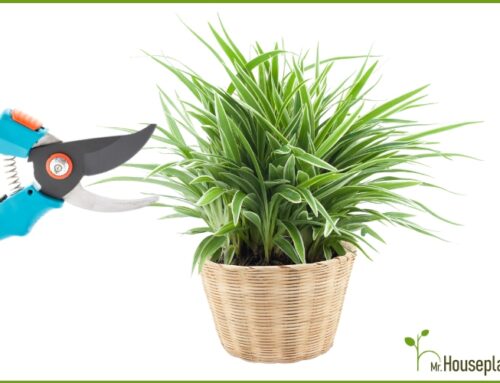

I just bought my first Calathea plant and I noticed little white spots are beginning to form on the leaves. Also, what kind of fertilizer should I use and since one is not suppose to feed them in the winter, should I wait now for spring to fertilize?
The idea of not fertilizing during winter comes from the general idea that houseplants go dormant in winter. However, that depends on the species, the amount of light in your home and other factors.
If your plant is actively growing (putting out new leaves) during winter, it’s ok to fertilize. I suggest Dyna Gro Foliage Pro, as it has all 16 micro and macro nutrients that plants need: https://www.mrhouseplant.com/recommends/dyna-gro-2/
As for the white spots, I’m afraid I can’t tell you much without seeing photos and knowing the exact calathea species you have :)
I’m thrilled to have found you! I’ve learned so much already. I hope that your experience will help me to up my game. I have excellent relationships with plants that thrive on neglect. Jade, Christmas cactus, philodendron… my orchids get more attention & have done well for years now. I do have some specific questions but need to look up a couple things first (plant names…). For now I just wanted to acknowledge your skill and share my delight. Thank you!
Hi Laurie, thank you so much, I’m really glad you find the content helpful! :)
Hi, I loved your article, thanks for naming all those plants and their lux needs. I am trying to figure [as a newbie] the light needs of my succulents from a 12 inch distance as they are on shelves. Do I divide the lux by 3 to get the lumens per foot. As I understand it [1 x lux = 1 x lumen per metre sq] so 12″ away in lumens is 3x stronger?
Hi Bernadette, thank you, I’m really glad you liked it, it took a lot of work :) Are you trying to determine the strength of natural light or the strength of a grow light for your succulents? Either way, you don’t need lumens.
If you’re looking at natural light, measure the amount of lux falling on the leaves with a light meter. If you’re looking at a grow light, measure the amount of PAR (photosythetic active radiation) that the plant is receiving on the leaves, with a PAR meter. Those are the only values are that relevant. Lumens present the amount of light emitted by a light source. But how much of that light reaches your plant from a distance of 12″ will be very different for each artificial light. I hope this helps. Btw, there is an excellent free light meter app that turns into a PAR meter for a few USD (PAR meters usually cost 500+ USD)
This page, and your entire site is very helpful. Thank you for all the work and for making it freely available.
Thank you so much Sowmya! :)
I have just ordered my second plant. I love them
That’s great Cindy :)
This page was so helpful and reassured me that adding more light from my grow light isn’t bad. I do have a question. Is it okay if I place multiple plants near my grow light that is placed into the soil of one of my plants?
Hi Anthony, actually, even though you cannot provide too much indirect light to a plant, you can provide too much light from a grow light. That’s because some grow lights are very strong and emulate direct sunlight :) And some tropical plants cannot tolerate a lot of direct sunlight.
Can you share the name of the grow light that you are using, so I can help with the distance from the plant and duration? I hope you are not using a halo grow light, as they are very weak. I wrote a review of halo grow lights here.